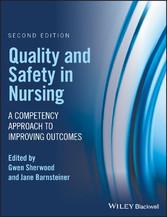
Quality and Safety in Nursing - A Competency Approach to Improving Outcomes

von: Gwen Sherwood, Jane Barnsteiner
Wiley-Blackwell, 2017
ISBN: 9781119151685
Sprache: Englisch
432 Seiten, Download: 6330 KB
Format: EPUB, auch als Online-Lesen
1
Driving Forces for Quality and Safety: Changing Mindsets to Improve Health Care
Gwen Sherwood, PhD, RN, FAAN, ANEF
Julia stashed her umbrella and looked at the overflowing waiting room of the Emergency Department (ED) where she had worked weekends for the past five years. It was summer and staffing was short even for a Sunday evening in August; several staff were on vacation and one called in sick. A storm had pounded the area, and there was a power outage. The hospital was on the emergency generators, and that meant the electronic chart was slow in response because of the overload. Staff were taking shortcuts due to time pressures. She thought about these breakdowns and remembered the workshop she recently attended on quality improvement. The focus had been on identifying problems and applying quality improvement tools to collect data on the problem, analyze results, and design solutions to close the gap between actual and desired practice. She noted that Ms. Masraf was in the waiting area; she had diabetes, and wounds were difficult to heal. Infection was a constant threat so she had been to the emergency department on several occasions. Julia turned at the sound of a crash and saw that one of the nurse aids had fallen where water had collected from wet umbrellas. Falls were common in the ED as a result of the population served. Patients may be unstable due to their disease condition or influence of alcohol or drug use. She wondered if she could initiate a quality improvement study on any of these continuing problems she saw every time she came to work. Other staff seemed to think this was just a part of how the emergency room functioned.
In 1999, the Institute of Medicine (IOM), a not‐for‐profit organization sponsored by the United States National Academy of Sciences, released To Err Is Human (2000), which estimated there were between 44,000 and 98,000 deaths each year as a result of medical harm. Makary and Daniel (2016) declare this number is both limited and out of date. Their projection released in 2016 cites the deaths due to medical error is more likely 251,454, making this the third leading cause of death in the United States. Since the IOM series of reports focused attention on the issues in health care quality and safety, responses have included regulatory changes, new roles and responsibilities for health care professionals, and calls for a new educational paradigm. Still, health care safety remains a major threat (Balik and Dopkiss, 2010; Cronenwett, 2012; Leape and Berwick, 2005; Wachter, 2004; Wachter, 2010).
The original 1999 report was the first evidence of the gap between the status of health care delivered and the quality of health care that the IOM panel believed Americans were entitled to receive. A number of reports have heralded ways to improve the system of care. The 2001 Crossing the Quality Chasm: A New Health System for the 21st Century issued recommendations for sweeping changes in our systems. This was followed by the 2003 IOM report, Health Professions Education: A Bridge to Quality, which called for a radical redesign of health professions education to achieve six core competencies described as essential to improve twenty‐first century health care: patient‐centered care, teamwork and collaboration, evidence‐based practice, quality improvement, safety, and informatics. The attention from the series of IOM reports over the past 15 years demonstrates that quality and safety are the leading contemporary issues in health care, contributing to costs and poor outcomes. Current health care reform in the United States is based on improving quality outcomes; health care mistakes cost the system between $17 billion and 29 billion each year and costs patients and families economically but also emotionally and physically. Providers who work in flawed systems and deal with inadequate resources experience dissatisfaction and low morale. For all, there is an erosion of trust from the pitfalls experienced.
Health professions education continues to undergo transformation to include preparation in the knowledge, skills, and attitudes (KSA) needed to improve our systems of care (Batalden, Leach, and Ogrinc, 2009; Cronenwett et al., 2007). In 2011, representatives of the major health professions worked together to reach consensus on four domains of interprofessional education competencies that crosswalk these competencies for improving quality and safety: roles and responsibilities, teamwork, communication, and ethics and values (Interprofessional Education Collaborative [IPEC], 2011).
The same questions from 15 years ago continue to need solutions. What are issues in redesigning our systems of care? How do we prepare health professionals with what they need to know and do? How can organizations develop cultures of quality and safety? This chapter will examine the impact of the driving forces for the changes needed, application of quality and safety science to reframe organizational cultures for quality improvement and safety, and a fresh look at how these reframe the education needs for nurses. In a safety culture, the paradigm shifts from individual performance to system initiatives and redesigns to monitor outcomes of care, and situates the patient as a full partner in care.
The Compelling Case for Quality and Safety
When the initial data revealed in the IOM Quality Chasm series of reports became public it, sent shock waves throughout the industry and grabbed the attention of consumers (Textbox 1.1). The evidence reported in this series identified the imperative for changing mindsets to include quality and safety as part of the everyday work of nurses and other health professionals. Prior to release of the first report in 1999, the issues were wrapped in silence; without a reporting system, there was not an evidence base to establish the scope or depth of system issues that contributed to poor quality and safety. There was no national tracking system and little pressure to improve quality and safety outcomes from regulators, health care purchasers, or third‐party payers. And, without just culture emphasis, there was little transparency or accountability in sharing information with patients and families who experienced harm.
Textbox 1.1 Summary: The Institute of Medicine Quality Chasm Series (www.iom.edu)
- To Err Is Human: Building a Safer Health System (2000)
This first IOM report presented the first aggregate data on the depth and breadth of quality and safety issues in US hospitals. Analysis of outcomes from hospitals in Colorado and Utah concluded that 44,000 people die each year as a result of medical errors and that in New York hospitals, the number is 98,000. Even using the lower number, more people die annually from medical error than from motor vehicle accidents, breast cancer, or AIDS. Medical errors are the leading cause of unexpected deaths in health care settings. Communication is the root cause of 65% of sentinel events. The report presents a strategy for reducing preventable medical errors with a goal of a 50% reduction over five years.
- Crossing the Quality Chasm: A New Health System for the 21st Century (2001)
The IOM issued a call for sweeping reform of the American health care system. A set of performance expectations for twenty‐first century health care seeks to assure that patient care is STEEEP. These aims provide the measures of quality to align incentives for payment and accountability based on quality improvements. The report includes causes of quality gaps and barriers to improve care. Health care organizations are analyzed as complex systems with recommendations for how system approaches can help implement change.
- Health Professions Education: A Bridge to Quality (2003)
Education is declared as the bridge to quality based on five competencies identified as essential for health professionals of the twenty‐first century: patient‐centered care, teamwork and collaboration, evidence‐based practice, quality improvement (and safety), and informatics. Recommendations include developing a common language to use across disciplines, integrating learning experiences, developing evidence‐based curricula and teaching approaches, initiating faculty development to model the core competencies, and implementing plans to monitor continued proficiency in the competencies.
- Keeping Patients Safe: Transforming the Work Environment of Nurses (2004)
The 2004 IOM report links nurses and their work environment with patient safety and quality of care. The findings of this report have helped shape the role of nurses in patient care quality and safety efforts. Key recommendations are creating a satisfying and rewarding work environment for nurses, providing adequate nurse staffing, focusing on patient safety at the level of organizational governing boards, incorporating evidence‐based management in the management of nursing services, building trust between nurses and organizational leaders, giving nurses a voice in patient care delivery through effective nursing leadership and participation in executive decision‐making, providing organizational support to promote learning for both new and experienced nurses, promoting interdisciplinary collaboration, and designing work environments and culture that promote patient safety.
- Identifying and Preventing Medication Errors (2006)
Medication errors make up the largest category of error with as many as 3–4% of patients experiencing a...









